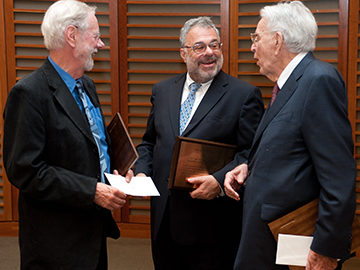
Medicinal beer brewed from drug-producing yeast.
A digital antibody assay so sensitive it could detect lung disease on a child’s breath.
Provocative ideas past and present ruled the day at the 2013 Warren Alpert Foundation Prize Scientific Symposium, held at Harvard Medical School on Oct. 3.
This year’s Alpert Award prize winners and other speakers emphasized the critical role of disruptive ideas in launching and advancing modern human genetics—and warned of the dangers of suppressing creative thinking in the next generation of researchers.
“In their time, the ideas we were advocating, teaching and implementing were not appreciated in the larger scientific community. Some people thought we were crazy. Some people thought we were dangerous,” said David Botstein of Princeton University, who received this year’s prize along with Ronald Davis and David Hogness, both of Stanford University School of Medicine.
The Alpert Prize recognizes researchers for basic discoveries that promise to improve human health. Botstein and Davis’ conceptual breakthrough, published in 1980, gave researchers the tools to trace and map out the genetic inheritance of disease in humans, while Hogness’ work provided the means of identifying the precise physical location of genes of interest on chromosomes.
Planting the seeds
The findings revolutionized human genetics, allowing researchers to identify disease genes and focus on potential treatments and cures.
Such breakthrough discoveries, however, were not—and still are not—necessarily received with open arms, the award-winning scientists said.
“We, in science, are not always understood contemporaneously,” said Botstein.
Sometimes, the speakers said, the wider community recoils from an idea because it is seen as too radical. Sometimes there is a lack of understanding because only a handful of specialists understand the work. Sometimes an idea only slowly gains acceptance because it crosses disciplines.
Hogness’ demonstration in 1974 that it was possible to clone random segments of DNA and map them back to their physical locations on the genome in fruit flies “was completely orthogonal to what the rest of the field was doing,” said symposium speaker Richard Lifton, chairman and Sterling Professor of genetics and professor of medicine at Yale University School of Medicine, who worked in Hogness’ lab at Stanford as a graduate student. “This really was the advance that led to the entire revolution in genomics as a field.”
Lifton spoke about the skepticism he faced himself early in his career when he began using genetic methods to seek the root causes of high blood pressure in the kidneys, rather than the cardiovascular system or adrenal glands. Beginning in 1994, his subsequent discoveries of 19 kidney gene mutations that raise or lower blood pressure have changed patient treatment guidelines.
Cross-pollination
Award recipient Davis recalled his early frustrations when human geneticists didn’t talk to yeast geneticists, who were pursuing the sort of mapping that eventually provided the key to unlocking the human genome.
These days, Davis said he facilitates innovation by connecting biologists with electrical engineers.
Symposium speaker David Altshuler, professor of genetics and medicine at HMS and Massachusetts General Hospital and the deputy director and chief academic officer at the Broad Institute of MIT and Harvard, agreed that interdisciplinary communication lies at the heart of scientific advancement.
“You speed progress by lowering barriers to people talking to each other,” he said.
Throughout the conference, speakers touched on the inherent challenges of encouraging creative thinking within the constraints of academic research. Botstein argued that conflicts can arise when peer review systems conserve the status quo instead of seeking out new ideas.
Altshuler pointed to a 1986 article dismissing the importance of identifying disease-linked genes because identification didn’t reveal anything new about biological function. He also shared an anecdote about how one of his own papers that revealed startling data about how “loss of function” mutations could be protective against disease was rejected in peer review because the findings disagreed with previous mouse studies.
Nurturing creativity
“We have lots of young people with really innovative, out-of-the-box ideas,” Botstein said. “We should be looking for those ideas and not trying to keep them out of the canon.”
That can be difficult when standard science education models emphasize memorization rather than problem-solving, he continued. Ubiquitous information and technology should be used to strengthen, rather than replace, students’ ability “to figure things out for themselves,” he said.
Although we live in a time of unprecedented technology, “Sometimes the best technology we have is the mental technology of thinking about an old problem in a new way,” said speaker Steven McCarroll, assistant professor of genetics at HMS and director of genetics for the Broad Institute’s Stanley Center for Psychiatric Research.


